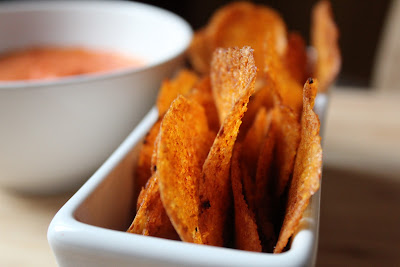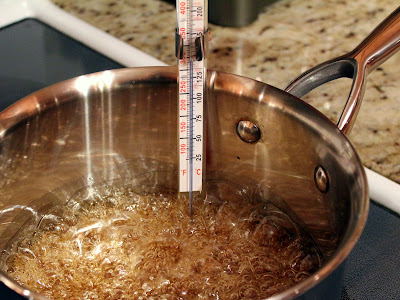If there's one thing I like, it's a challenge. So when my friend Sarah R.C. suggested that I check out
Sodium Girl's website and participate in her
Love Your Heart Recipe Rally, I said, sign. me. up. But seriously, making a low sodium dish? That didn't even sound like a challenge, more like just a new theme for a post. Boy did I get a double dose of sodium reality. Cutting out the Na is hard, folks.
"Sodium Girl" Jess was diagnosed with Lupus in 2004 and has since had to severely curtail the sodium in her diet. But she hasn't let that stop her from eating delish foods everyday (or so it appears from her posts). You can read her story
here. In honor of National Heart Health Month, Jess organized the Love Your Heart Recipe Rally to bring bloggers together in posting heart-healthy, low-sodium recipes.
The parameters for the Rally were to pick a typically salty dish that you love, identify the ingredients that are high in sodium and then craft a low-sodium alternative recipe. The goal was to keep each serving under 40mg of sodium. Now, if you, like me, have never monitored your sodium intake, that number means nothing to you. To put it into perspective, the average American takes in more than 3,400mg of sodium per day.*
Oy. And I'm supposed to make something tasty with less than 40mg/serving? More challenging than I thought.
*The USDA has recently recommended limiting that intake to 1,500mg to 2,300mg per day, depending on your age and other health factors. Check out the USDA's new key recommendations for what we should be ingesting each day. For my Rally recipe, I chose the classic salty snack of chips & dip. Here is your typical sodium intake after one serving of chips & dip:
Potato Chips & Onion Dip
Tortilla Chips & Salsa
Let's get to work.
For my take on the chips, I decided to do a homemade "frito" with yellow corn grits. Corn grits, also known as polenta, are like cornmeal, but more coarsely ground. Any store that sells Bob's Red Mill products should carry the grits. And for the dip, I wanted something creamy - akin to southwestern ranch. Since I love red pepper hummus, a roasted red pepper seemed like the perfect sodium-free route to flavor in my dip.
If you've never roasted your own peppers before, do it. Now. With this recipe. It's a really cool process and it feels good to go from a fresh veggie to a healthy, tasty dip.
Like I said, I've never paid close attention to how much sodium is in my diet. I could probably tell you down to the calorie the breakdown of fats, protein and carbs, the fiber content and the sugar levels of most things I eat. But sodium? No sé. Initially, I kind of thought I could process a pepper and some lowfat yogurt or sour cream and BOOM, I'd have an awesome dip. Not so much. When I first tasted the pepper puree mixed with sour cream and a dash of chili pepper, I was bummed at how bland it was. :( I looked through my cupboards and everything I wanted to add was chock-full o'sodium. Hot cherry peppers in a jar, sliced jalapenos, canned green chilies, white beans - sodium, sodium, sodium!
And adding even a smidge of salt to the dip was out of the question. One teaspoon of table salt contains 2,300mg of sodium. So even if I sprinkled in a scant 1/16 teaspoon of salt (a few shakes or grinds), I would have been adding over 140mg of sodium to the two-serving dip, which would blow my 40mg/serving limit.
After poking around Jess's site, I decided that vinegar might give the dip the tang I was looking for - and it did! That and some cumin and I was starting to have the semblance of a dip worthy of my chips (which came out awesome by the way - the trick is to spread the corn mixture as thinly as possible before baking).
While I have no intention of going sodium crazy and cutting out all the salt in my life, this exercise opened my eyes to a part of my diet that I was paying zero attention to. Previously, I wouldn't have given any thought to whether I put two grinds of salt or four into my eggs. Only now do I realize how much each grind counts! And I discovered that all of my flavor go-tos were in cans or jars (and thus rife with added sodium). Maybe I'm getting more sodium than I thought and maybe it's time to pay a bit more attention to how I flavor my foods.
On Tuesday, the Washington Post published a timely article with the tagline, "How hard is it to reduce your salt?" According to staff writer Tim Carman, who went low-so for one week, very. I think he wanted to bath in canned soup after every salt-deprived meal. Carman's approach may have been a bit aggressive based on his admitted predilection for salty foods, but his overall result was positive: increased awareness of sodium levels and identification of a few nutritional gaps in his diet. Mr. Carman and I both learned a lot this week.
Thanks to Jess for the healthy inspiration! Links to the other Rally recipes will be available on Sodium Girl today, along with Jess's arsenal of low-sodium tips and meal suggestions. And with that, I give you my Love Your Heart recipe. Here's to healthy ticking.
Spicy Polenta Chips
Makes around 36 chips; serves 2
-1/2 cup polenta (aka corn grits)
-3/4 cups boiling water
-1 tsp. olive oil
-paprika
Preheat oven to 450 degrees. Mix polenta and chili powder in a bowl. Add boiling water and olive oil, stirring well. Wait a few minutes to allow the corn to absorb the water. Spoon 1/2 teaspoon to 1 teaspoon-sized dollops of mix onto a parchment lined cookie sheet. Using the back of a spoon, spread the corn mix into a disk as thinly as possible without having big holes. Sprinkle chips with paprika. Cook the chips at 450 for 10-11 minutes or until they start to brown and lift up at the edges.
Nutrition (per serving): 10mg sodium, 150 calories, 2.5g fat, 1g saturated fat, 27g carbs, 1g fiber, 1.5g protein
Roasted Red Pepper Dip
Makes 1 cup; serves 2
-1 red pepper, roasted, skinned and seeded
-1 tbs. vegetable oil
-1/4 cup low fat sour cream (check sodium content)
-1/2 tsp. chipotle chili pepper
-1/2 tsp. cumin
-2 tsp. good vinegar (I used a white balsamic)
-paprika
Set your oven to a high broil (or around 500 degree). Coat bell pepper in vegetable oil using a basting brush or your fingers. Because of the high cooking temperature, stick with vegetable or canola oil and not olive oil. Place whole pepper on its side in a pan and put in the oven. Rotate the pepper on its side a 1/4 turn every 3 to 5 minutes. You want the skin to get blackened, but not split open. Total roasting time should be 15-20 minutes, rotating as needed for an even char.
Remove pepper from the oven and place in bowl with a cover. Let pepper sit covered, steaming for 10-15 minutes. Once pepper is cool enough to handle, peel off the skin. Then pull off the stem and scrape out the seeds. Squeeze out any excess juice as you do so.
Slice the roasted pepper into 4 or 5 chunks, making sure to remove any blackened skin or seeds. Place roasted pepper chunks in a food processor and process for 30 seconds, scraping down the sides as needed. Let pepper puree sit until completely cooled. If any excess liquid collects, drain the puree.
Add sour cream, chili pepper, cumin and vinegar to the puree. Stir well or process for another 15 seconds. Refrigerate for at least an hour. Garnish with paprika. Enjoy with homemade spicy polenta chips.
Nutrition (per serving): 20mg sodium, 90 calories, 4g fat, 2g saturated fat, 20g carbs, 1g fiber, .5g protein





































